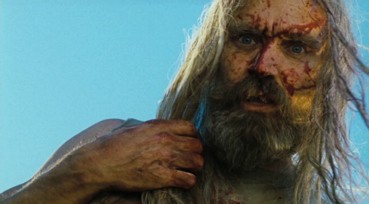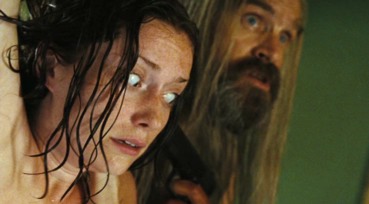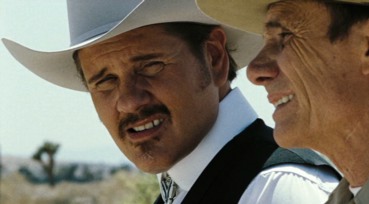|
In
movies and in rock music, names count for a lot.
One only has to think of Boris Karloff, a splendid name
for an actor who became a horror icon but who was born
William Henry Pratt, hardly the stuff of Hollywood billboards.
Over in the music world there's Vincent Damon Furnier, actually
not a bad name for a rock god but not as iconic as his
chosen moniker, Alice Cooper. And then there's Robert Cummings,
a close friend of Cooper's who has crossed into both worlds,
making his name as a rock musician and more recently
as a movie director, both careers inspired in part by his
own passion for horror films. Of course, Robert Cummings
is no name for the lead singer of hardcore rock band, which
is how Mr. Cummings became Rob Zombie.
Zombie's directorial career kicked off in 2003 with the
low budget House of 1000 Corpses, an entertaining
and imaginative riff on Tobe Hooper's The Texas Chain Saw
Massacre by way of the same director's The
Funhouse, Alex Winter and Tom Stern's Freaked,
and at least half a dozen others, liberally sprayed with
a coating of MTV. It's only real problem as a horror film
was that we never got to identify with either the aggressors
or their victims, so fear is never a factor. But the dialogue
was snappy, the visual realisation inventive, the performances
energetic and the use of music often inspired.

In
fashioning a sequel, Zombie wisely chose not to repeat himself
stylistically, shaking off the first film's tongue-in-cheek
approach and opting for a considerably darker, more realistic
tone. Set something like four years on from 1000
Corpses, it opens with a police raid on the homestead
of the mass-murderous Firefly family. The raid is led by the
furiously no-nonsense Sheriff John Quincey Wydell, whose
brother George was killed by the family in the first film
and who now sees himself as a sword of vengeance on a mission
from God. A massive shoot-out follows, during which brother
Rufus is killed, Mother Firefly is captured, and the brother-sister
team of Otis and Baby escape.
Right
off the bat we are in different territory to the original,
with the gloomily observed body of a young girl being dragged
naked through the woods by towering figured of Tiny, the
family's monster-in-the-attic and this film's weapon from the first act that will find function in the last. The
shoot-out that follows vividly captures the mayhem of armed
battle, but more crucially invites us to do something we
never did in the first film, to take sides. With Sheriff
Wydell spouting blood and thunder from the moment he steps
out of his cruiser, the Firefly family are presented very
much in Western terms as outlaws cornered by Texas
Rangers, the James Gang making a last stand against the
brutal overkill of authority. With the stylistic shift it's
easy at this point to forget that we're dealing with mass
murderers, although the transformation of Otis into
a Charles Manson lookalike should keep the idea buzzing
at the back of the brain.
All
this changes when Otis and Baby arrive at the motel at which
they have agreed to meet part-time and manic middle-aged clown
(and Baby's father) Captain Spaulding, where they invade the room
of a newly arrived travelling musical group, killing their
roadie and mentally torturing and ultimately slaughtering
the rest. It's a serious narrative turning point because
it's played absolutely straight and is one of the most
genuinely unpleasant sequences you'll see in a film all
year, as it was meant to be. It is here that our allegiance
to the family breaks and we have our faces rubbed in just
what it means to make cinematic heroes out of horror movie bad
guys. In doing so, though, it relies on some familiar generic
gender divisions – men are assaulted, abused and killed,
whereas women are assaulted, humiliated, sexually abused
and killed. That said, Zombie at no point presents this
for titillation, which is part of why the scene is so effective
in turning the Firefly family from rebels to thoroughly
unsympathetic bastards.

But
from here on in things get a little tricky. Having turned
us against the killers, Zombie refuses to offer up an alternative
point of empathic contact, with Wydell's increasing brutality
and demented religious fervour turning him into a sociopath
of equally dangerous potential. It is clear that this is
the director's intent, a refusal to see things in simple
black-and-white terms, but while an admirable aim in itself, the
downside is that there is no-one to emotionally engage with
and it becomes a case of just dispassionately watching one
side hunt and violently assault the other. Having said this,
it's not long before Zombie points us back towards
the Firefly family, attempting to drag us, in his own words,
"towards the dark side." Unpleasant though this
concept may seem, I personally don't have a problem with
it, as requiring an audience to sympathise on some level
with characters they actually dislike or are even repulsed
by has given rise to some of film history's most compelling
works. No, the problem I have is in how it does it, relying
not on the undeniable intrigue and even dark charisma of
the characters themselves, but a series of rather clunky attempts
to show them as just a bunch of ordinary, fun-loving guys
and gals who are just like the rest of us. This includes a rather
irritating whine about wanting ice cream that concludes in one of
the hoariest clichés known to movies, as one character
repeatedly refuses to do something and on the very next
edit are shown to have given in and are doing it, and
coming so soon after the previous slaughter, it tends to
stick in the throat. Later, Zombie goes the whole hog
with a series of idealised, home-movie style flashbacks
of Otis, Baby and the Captain cavorting like a happy family
in a way that is clearly meant to bring a tear to the eye,
but made me laugh out loud at its bare-faced cheesiness.
Zombie's extensive film knowledge and love of movie trivia
is visible in both the dialogue's post-modernist film-referencing
and the extensive borrowings from and influence of other
film works, including The Texas Chainsaw Massacre
(obviously a favourite of the director's), Ned Kelly,
Natural Born Killers, Taxi Driver,
Butch Cassidy and the Sundance Kid, The
Shining, The Most Dangerous Game
and Pat Garret & Billy the Kid to name
a few. This is further reflected in the casting of smaller
roles, with familiar faces from cult films of the late 70s – the period in which this film is set – including Michael Berryman
(The Hills Have Eyes and Deadly
Blessing), P.J. Soles (Halloween,
Rock 'n' Roll High School), and Deborah
Van Valkenburgh (The Warriors). To Zombie's credit, this genuinely appears to have arisen out of his desire
to work with actors he admired rather than any winking at
the audience, hence the presence of favourite character actors
Geoffrey Lewis and Steve Railsback, although the latter's
role as the most famed of mass murderers, Ed Gein, in Chuck
Parello's 2000 film of the same name can't help but strike
a chord.
In other respects, The Devil's Rejects is
an impressive piece of work. Camera placement and editing
are consistently excellent and Zombie's decision to hire DoP
Phil Parmet – who began his career working on Barbara Kopple's
documentary vérité classic Harlan
County USA – really pays of, visually grounding
the film in a reality that is nonethless tinged with menace.
The performances are pretty much on the nose, with Bill
Mosely in particular making Otis a genuinely threatening
and dangerous figure. The absence of Karen Black from the first film is more than
compensated for by Leslie Easterbrook's explosive turn as Mother
Firefly, and William Forsythe spits fire as Sheriff Wydell,
a movie lawman of the old school who specifically recalls
R.G. Armstrong's brutal, religiously obsessed Deputy Bob
Ollinger in Sam Peckinpah's aforementioned Pat Garrett & Billy
the Kid.

A classy piece of work all round that showcases well
Zombie's increasingly impressive film-making skills, it also scores points for daring to be dangerous rather than play
it generically safe. But in the process there remains some
confusion over just what it is trying to achieve.
As a Funny Games style attempt to force
the audience to reconsider their attitude to movie violence
it ultimately fails because it's had horror audiences everywhere cheering
for the killers, and the 'getting to like people despite
what they've done' angle stumbles because of the aforementioned
clumsiness in the engagement process. Some have even suggested
parallels with Bonnie and Clyde, which
simply doesn't wash, Otis and Baby having none of the likeability
and genuine charm that Beatty and Dunaway brought to their
characters. It may not matter. A sizeable portion of
the film's target audience couldn't care less about moral and
ethical issues and will be happy enough with the on-screen
violence and sadistic nastiness, and will openly celebrate
the fact that portions of the film are designed to cause
offence. As special effects make-up artist Wayne Toth observes
in the accompanying documentary, "By the end of the
film you don't really even know who to root for – is there
a good guy or is there not? – it's really just a violent,
entertainment spectacle." It seems almost indicative
of the film's intermittent schizophrenia that in the very
same documentary Zombie claims, "I never wanted the
violence to be exciting...I just think it's...stupid."
Considering
the film was shot on Super-16 and blown up to 35mm, the image
on display here is first rate, displaying a level of detail
that would shame some 35mm transfers I've clapped eyes on recently. Colour and contrast
are also bang on, the punched-out highlights being a deliberate
choice by director and cinematographer. Some grain is evident,
but is never intrusive. Exteriors in particular effectively
capture the look of 'Out West' horror works of the 1970s,
in part because of their sometimes shared 16mm origins.
There
are two soundtracks on offer, Dolby 5.1 and DTS 6.1. There's
actually not a huge amount to chose between them for the
most part, but in key scenes the DTS track really has the
edge – in the opening shoot-out, for example, bullets and
gunfire come at you from every direction and at considerable
volume, really placing you in the middle of the action and
the confusion.
Increasingly,
low budget cult films seem to be getting better DVD handling
than their more mainstream counterparts, and Momentum's
2-disk special edition of The Devil's Rejects is a prime example.
First
up there is a commentary by director
Rob Zombie. Zombie is an intelligent and knowledgeable film-maker
and provides a consistently interesting and information-packed
guide to the making of the film, working with the actors
and the handling of individual scenes, not least the tortuous
hostage sequence, which was clearly an upsetting experience
for both actors and crew, something I actually found comforting.
He does tell us that Bill Mosely was happy to play his first
scene – in which he is seen sleeping with the corpse of
a young girl – in the nude, but Zombie declined because
"I didn't want to deal with a naked Bill Moseley all
day." He seemed fine with a naked Kate Norby and the
stunt girl dragged through the woods for the opening, though.
Zombie is clearly very aware of both his film influences
and his intent, and supplies some nice technical details – I always warm to news that the director created images
for the film in Photoshop on his home computer when the
original didn't look quite how he had hoped.
A
second commentary with actors
Sid Haig, Bill Moseley and Sherri Moon Zombie (the director's
wife) is less essential, in part because of its more jocular
nature, with the three initially laughing at just about
everything they see and say, though they do supply some
useful background to their approach to their characters
and the experience of working with others on the film. Moseley
admits he would probably not show the finished work to his
daughters, suggesting they go see Howl's Moving
Castle ("It's out now! It's good!") instead.
He also says "Awesome!" an awful lot.
The
rest of the extras are on disk 2.
The
main inclusion here is the documentary, 30 Days
in Hell: The Making of The Devil's Rejects
(144:54). No, that figure in the brackets is not a typo,
it's the actual running time – this documentary does indeed
run for two and a quarter hours, half-an-hour longer than
the main feature. And it's terrific. Essentially a third party-shot
diary of the production, it covers pre-production planning,
rehearsals and every single day of the shoot in a fair amount
of detail, with on-set footage cut with grabbed interviews,
before-and-after special effects sequences, storyboard comparisons,
even the recording of the score. There's a fair amount of
praise for Zombie and the camaraderie of the shoot (a familiar
claim on low-budget movies, but nice all the same), and
Zombie himself comes of as even smarter than he already
appeared. It makes for thoroughly enjoyable viewing, and
that's coming from someone who, having seen the film four
times in a row by this point and thought he'd seen quite enough of it.
Buck
Owen's video: "Satan's Going to Have to Get Along Without
Me" (1:53) is the full version of a video
seen playing on TV in the film. It is framed 4:3 and has
REALLY crispy sound.
Bloody
Stand-Up (2:17) has Brian Poshen, who plays
the unfortunate Jimmy, doing a not very funny improvised
stand-up routine in his hole-in-the-head make-up during
a filming break.
Mary
the Monkey Girl Commercial (1:10) is the full
version of the said commercial, seen in part in the film.
Tribute
to Matthew McGrory (2:07) has a brief interview
with the giant actor who plays Tiny and who died this year,
intercut with footage of him on set. The music playing in
the background makes it difficult to clearly hear what he
is saying at times.
Page
2 kicks off with 11 Deleted Scenes,
most of which are less than a minute long, but which include
two longer sequences – Otis and Candy Make Funky Music
(3:40) and Personal Escorts into Hell (1:46) – that are discussed in the documentary or commentary. All
scenes are edited and scored and are presented in non-anamorphic
widescreen.
Bloopers
(5:22) is a fun collection of gaffes, nicely cut together
and occasionally enhanced with some crude graphical assistance.
Spaulding
Xmas Commercial (1.08) is a second Captain
Spaulding commercial, not used in the film but discussed
on the actor's commentary.
Otis'
Home Movie (0:51) is a dark, flickery, hand-held
shot of Otis attacking a woman. A chance for you all to
play Henry: Portrait of a Serial Killer
by repeatedly watching and rewinding it.
Make-Up
Test (13:10) is film footage of make-up tests
for the lead characters, including Dr. Satan, whose scene
was cut out.
The
Morris Green Show (13:18) is the full version
of the show seen playing at the start of the hostage scene.
It's intriguing enough that they chose to shoot the whole
thing rather than just one sequence, but it's principal
attraction is how funny it is, with Daniel Roebuck running
with the role of shallow, self-centred talk show host Green.
There's a nice little reference in there too, as Green explains
the cancellation of original guest Bob Crane due to the
announcement of "shocking revelations in the newspaper."
Although actually referring to the raiding of the Firefly house,
it alludes to the discovery of Crane's body following
his violent murder in 1978.
Finally
we have the Theatrical Trailer,
which is non-anamorphic widescreen.
Whatever
your view on the finished work, if you're a horror fan you
most definitely should check out The Devil's Rejects,
for its skillful direction, for its sassy use of source
music, for its threatening atmosphere, for its performances,
and for daring to take its audience to genuinely dangerous
places. Far better than some of its detractors have claimed,
it's also not the classic it has been championed as by less
discerning horror fans, some of whom might do well to reflect
on what such uncritical adoration of such unpleasant characters
might say about them.
That
said, if you were impressed with the film on any level, then Momentum's
special edition DVD is an absolute must, for its picture
and sound, for its two commentary tracks, for its epic 'making-of'
documentary and its bucket-load of other worthwhile extras.
|